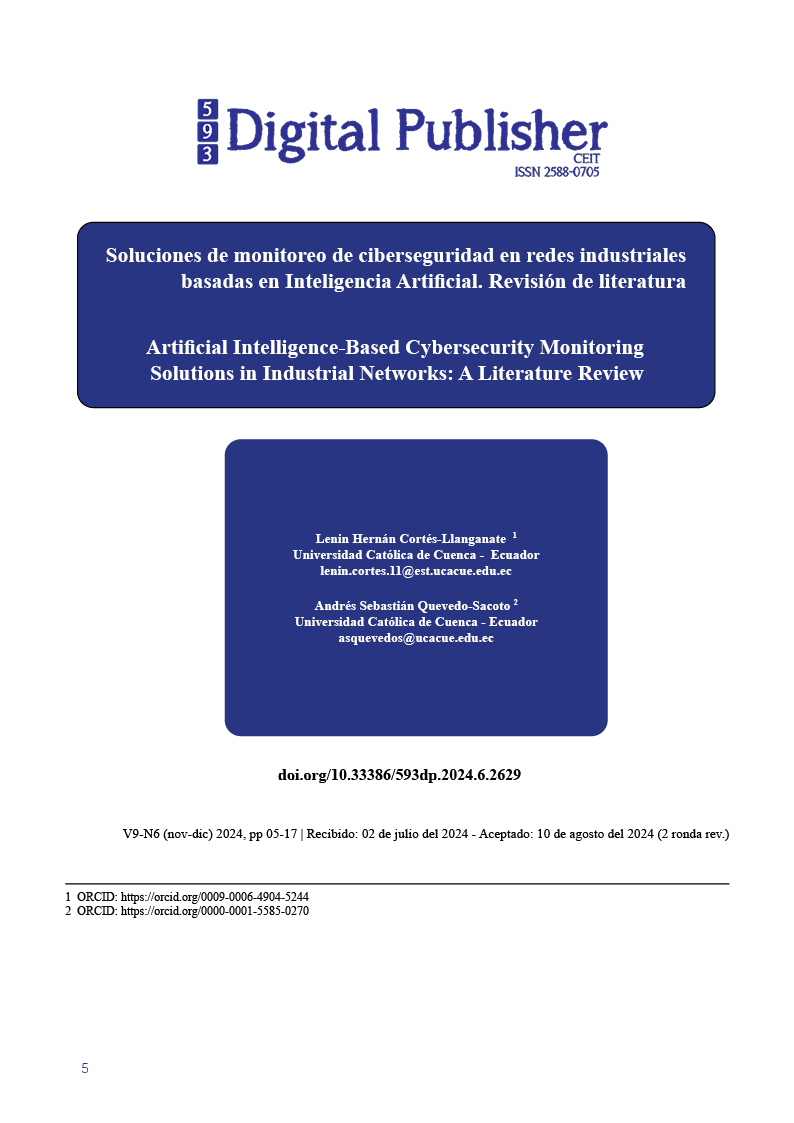Artificial Intelligence-Based Cybersecurity Monitoring Solutions in Industrial Networks: A Literature Review
Main Article Content
Abstract
The convergence of operational technologies (OT) with information technologies (IT) has significantly increased the risk of industrial networks suffering from cyber-attacks. The objective of this article has been to systematically review the existing literature on cybersecurity monitoring solutions in industrial networks based on artificial intelligence (AI), with the purpose of identifying the main manufacturers, solutions, functionalities, and industrial sectors where this technology is applied. The PRISMA method has been used to conduct a systematic search for documentation containing relevant information in the last 7 years. The results obtained show that there are manufacturers such as Nozomi Networks, Claroty, Dragos, and Darktrace, which have AI-based cybersecurity monitoring solutions. These solutions have functionalities such as asset and communication identification, behavior analysis, vulnerability management, and threat intelligence. It is also identified that these technologies are being applied in different industrial sectors, such as energy, oil and gas, water and sanitation, among others. It is concluded that the adoption of these type of technologies is of vital importance for the faster and more accurate detection of cyber threats in critical infrastructures, which is why it is important to continue investing in the development and application of these solutions.
Downloads
Article Details

This work is licensed under a Creative Commons Attribution-NonCommercial-ShareAlike 4.0 International License.
1. Derechos de autor
Las obras que se publican en 593 Digital Publisher CEIT están sujetas a los siguientes términos:
1.1. 593 Digital Publisher CEIT, conserva los derechos patrimoniales (copyright) de las obras publicadas, favorece y permite la reutilización de las mismas bajo la licencia Licencia Creative Commons 4.0 de Reconocimiento-NoComercial-CompartirIgual 4.0, por lo cual se pueden copiar, usar, difundir, transmitir y exponer públicamente, siempre que:
1.1.a. Se cite la autoría y fuente original de su publicación (revista, editorial, URL).
1.1.b. No se usen para fines comerciales u onerosos.
1.1.c. Se mencione la existencia y especificaciones de esta licencia de uso.
References
Alghassab, M. (2022). Analyzing the impact of cybersecurity on monitoring and control systems in the energy sector. Energies, 15(1). https://doi.org/10.3390/en15010218.
Alkahtani, H., & Aldhyani, T. H. H. (2022). Developing Cybersecurity Systems Based on Machine Learning and Deep Learning Algorithms for Protecting Food Security Systems: Industrial Control Systems. Electronics (Switzerland), 11(11). https://doi.org/10.3390/electronics11111717
Alotaibi, B. (2023). A Survey on Industrial Internet of Things Security: Requirements, Attacks, AI-Based Solutions, and Edge Computing Opportunities. In Sensors (Vol. 23, Issue 17). Multidisciplinary Digital Publishing Institute (MDPI). https://doi.org/10.3390/s23177470
Bécue, A., Praça, I., & Gama, J. (2021). Artificial intelligence, cyber-threats and Industry 4.0: challenges and opportunities. Artificial Intelligence Review, 54(5), 3849–3886. https://doi.org/10.1007/s10462-020-09942-2
Berindei, A.-M., Ilie, C., & Florentina, B. (2023). The Cyber Security Paradigm in Industry 4.0. In International Journal of Mechatronics and Applied Mechanics (Issue 13)
Boye, F., & Onate, T. (2023). Analysis on Cybersecurity Control and Monitoring Techniques in Industrial IoT: Industrial Control Systems. Internet of Things and Cloud Computing. https://doi.org/10.11648/j.iotcc.20231101.11
Claroty ©. (2024). SOLUTION OVERVIEW Claroty Continuous Threat Detection. https://web-assets.claroty.com/resource-downloads/ctd-overview-2024.pdf
Darktrace ©. (2023). A Comprehensive Guide to OT Security. https://cdn.prod.website-files.com/626ff4d25aca2edf4325ff97/6557cf544fbbb42fd1bbd84c_A%20Comprehensive%20Guide%20to%20OT%20Security.pdf
Darktrace ©. (2024). Darktrace/OT The Most Comprehensive Prevention, Detection, and Response Solution Purpose Built for Critical Infrastructures. https://darktrace.com/es/resources/ot-solution-brief
Dragos ©. (2023). Datasheet Dragos Platform. https://www.dragos.com/wp-content/uploads/2021/07/Dragos-Platform-Datasheet-2.pdf
Dragos ©. (2024). OT CYBERSECURITY THE 2023 YEAR IN REVIEW. https://hub.dragos.com/hubfs/312-Year-in-Review/2023/Dragos-2023-Year-in-Review-Full-Report.pdf?hsLang=en
Houmb, S. H., Iversen, F., Ewald, R., Faeraas, E., & Asa, E. (2023). Intelligent Risk-Based Cybersecurity Protection for Industrial Systems Control-A Feasibility Study. In SPE Journal (Vol. 3272). http://onepetro.org/SJ/article-pdf/28/06/3272/3333567/spe-217430-pa.pdf/1
Hurd, C. M., & Mccarty, M. V. (2017). A Survey of Security Tools for the Industrial Control System Environment. http://www.inl.gov
Mubarak, S., Habaebi, M. H., Islam, M. R., Balla, A., Tahir, M., Elsheikh, E. A. A., & Suliman, F. M. (2022). Industrial datasets with ICS testbed and attack detection using machine learning techniques. Intelligent Automation and Soft Computing, 31(3), 1345–1360. https://doi.org/10.32604/IASC.2022.020801
Muhammad, A. R., Sukarno, P., & Wardana, A. A. (2022). Integrated Security Information and Event Management (SIEM) with Intrusion Detection System (IDS) for Live Analysis based on Machine Learning. Procedia Computer Science, 217, 1406–1415. https://doi.org/10.1016/j.procs.2022.12.339
Nankya, M., Chataut, R., & Akl, R. (2023). Securing Industrial Control Systems: Components, Cyber Threats, and Machine Learning-Driven Defense Strategies. In Sensors (Basel, Switzerland) (Vol. 23, Issue 21). https://doi.org/10.3390/s23218840
Nozomi Networks ©. (2024). Overview Nozomi Networks Platform. https://cdn.prod.website-files.com/645a4534705010e2cb244f50/65b121e2e08c0ab6e6b0278d_Nozomi-Networks-Platform-Overview.pdf
Page, M. J., McKenzie, J. E., Bossuyt, P. M., Boutron, I., Hoffmann, T. C., Mulrow, C. D., Shamseer, L., Tetzlaff, J. M., Akl, E. A., Brennan, S. E., Chou, R., Glanville, J., Grimshaw, J. M., Hróbjartsson, A., Lalu, M. M., Li, T., Loder, E. W., Mayo-Wilson, E., McDonald, S., … Moher, D. (2021). The PRISMA 2020 statement: An updated guideline for reporting systematic reviews. In The BMJ (Vol. 372). BMJ Publishing Group. https://doi.org/10.1136/bmj.n71
Pochmara, J., & Świetlicka, A. (2024). Cybersecurity of Industrial Systems—A 2023 Report. Electronics (Switzerland), 13(7). https://doi.org/10.3390/electronics13071191
Rubio, J. E., Alcaraz, C., Roman, R., & Lopez, J. (2019). Current cyber-defense trends in industrial control systems. Computers and Security, 87. https://doi.org/10.1016/j.cose.2019.06.015
Schmitt, M. (2023). Securing the digital world: Protecting smart infrastructures and digital industries with artificial intelligence (AI)-enabled malware and intrusion detection. Journal of Industrial Information Integration, 36. https://doi.org/10.1016/j.jii.2023.100520
Soliman, S., Oudah, W., & Aljuhani, A. (2023). Deep learning-based intrusion detection approach for securing industrial Internet of Things. Alexandria Engineering Journal, 81, 371–383. https://doi.org/10.1016/j.aej.2023.09.023
Stouffer, K., Pease, M., Tang, C., Zimmerman, T., Pillitteri, V., Lightman, S., Hahn, A., Saravia, S., Sherule, A., & Thompson, M. (2023). Guide to Operational Technology (OT) security. https://doi.org/10.6028/NIST.SP.800-82r3
Thielemann, K., & Voster, W. (2023). Market Guide for CPS Protection Platforms. https://www.gartner.com/doc/reprints?id=1-2EDWF9AQ&ct=230705&st=sb
Ullah Khan, I., Ouaissa, M., Ouaissa, M., Abou El Houda, Z., & Fazal Ijaz, M. (2023). Cyber Security for Next-Generation Computing Technologies. CRC Press. https://doi.org/10.1201/9781003404361
Ye, F., & Zhao, W. (2022). A Semi-Self-Supervised Intrusion Detection System for Multilevel Industrial Cyber Protection. Computational Intelligence and Neuroscience, 2022. https://doi.org/10.1155/2022/4043309
Zhang, S., Liu, Y., & Yang, D. (2022). A Novel IDS Securing Industrial Control System of Critical Infrastructure Using Deception Technology. International Journal of Digital Crime and Forensics, 14(2), 1–20. https://doi.org/10.4018/ijdcf.302874



